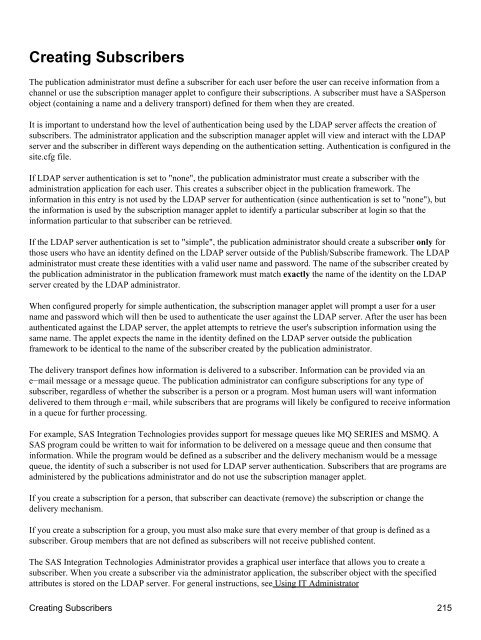SAS® Integration Technologies: Administrator's Guide (LDAP Version)
SAS® Integration Technologies: Administrator's Guide (LDAP Version)
SAS® Integration Technologies: Administrator's Guide (LDAP Version)
You also want an ePaper? Increase the reach of your titles
YUMPU automatically turns print PDFs into web optimized ePapers that Google loves.
Creating Subscribers<br />
The publication administrator must define a subscriber for each user before the user can receive information from a<br />
channel or use the subscription manager applet to configure their subscriptions. A subscriber must have a SASperson<br />
object (containing a name and a delivery transport) defined for them when they are created.<br />
It is important to understand how the level of authentication being used by the <strong>LDAP</strong> server affects the creation of<br />
subscribers. The administrator application and the subscription manager applet will view and interact with the <strong>LDAP</strong><br />
server and the subscriber in different ways depending on the authentication setting. Authentication is configured in the<br />
site.cfg file.<br />
If <strong>LDAP</strong> server authentication is set to "none", the publication administrator must create a subscriber with the<br />
administration application for each user. This creates a subscriber object in the publication framework. The<br />
information in this entry is not used by the <strong>LDAP</strong> server for authentication (since authentication is set to "none"), but<br />
the information is used by the subscription manager applet to identify a particular subscriber at login so that the<br />
information particular to that subscriber can be retrieved.<br />
If the <strong>LDAP</strong> server authentication is set to "simple", the publication administrator should create a subscriber only for<br />
those users who have an identity defined on the <strong>LDAP</strong> server outside of the Publish/Subscribe framework. The <strong>LDAP</strong><br />
administrator must create these identities with a valid user name and password. The name of the subscriber created by<br />
the publication administrator in the publication framework must match exactly the name of the identity on the <strong>LDAP</strong><br />
server created by the <strong>LDAP</strong> administrator.<br />
When configured properly for simple authentication, the subscription manager applet will prompt a user for a user<br />
name and password which will then be used to authenticate the user against the <strong>LDAP</strong> server. After the user has been<br />
authenticated against the <strong>LDAP</strong> server, the applet attempts to retrieve the user's subscription information using the<br />
same name. The applet expects the name in the identity defined on the <strong>LDAP</strong> server outside the publication<br />
framework to be identical to the name of the subscriber created by the publication administrator.<br />
The delivery transport defines how information is delivered to a subscriber. Information can be provided via an<br />
e−mail message or a message queue. The publication administrator can configure subscriptions for any type of<br />
subscriber, regardless of whether the subscriber is a person or a program. Most human users will want information<br />
delivered to them through e−mail, while subscribers that are programs will likely be configured to receive information<br />
in a queue for further processing.<br />
For example, SAS <strong>Integration</strong> <strong>Technologies</strong> provides support for message queues like MQ SERIES and MSMQ. A<br />
SAS program could be written to wait for information to be delivered on a message queue and then consume that<br />
information. While the program would be defined as a subscriber and the delivery mechanism would be a message<br />
queue, the identity of such a subscriber is not used for <strong>LDAP</strong> server authentication. Subscribers that are programs are<br />
administered by the publications administrator and do not use the subscription manager applet.<br />
If you create a subscription for a person, that subscriber can deactivate (remove) the subscription or change the<br />
delivery mechanism.<br />
If you create a subscription for a group, you must also make sure that every member of that group is defined as a<br />
subscriber. Group members that are not defined as subscribers will not receive published content.<br />
The SAS <strong>Integration</strong> <strong>Technologies</strong> Administrator provides a graphical user interface that allows you to create a<br />
subscriber. When you create a subscriber via the administrator application, the subscriber object with the specified<br />
attributes is stored on the <strong>LDAP</strong> server. For general instructions, see Using IT Administrator<br />
Creating Subscribers 215
















